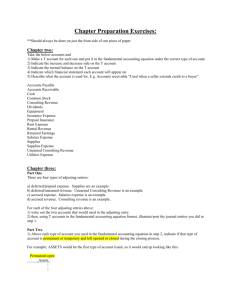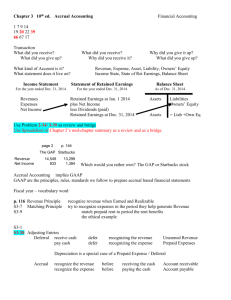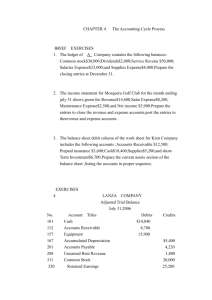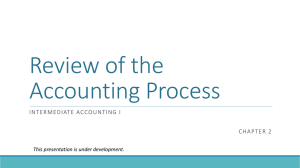Down
advertisement
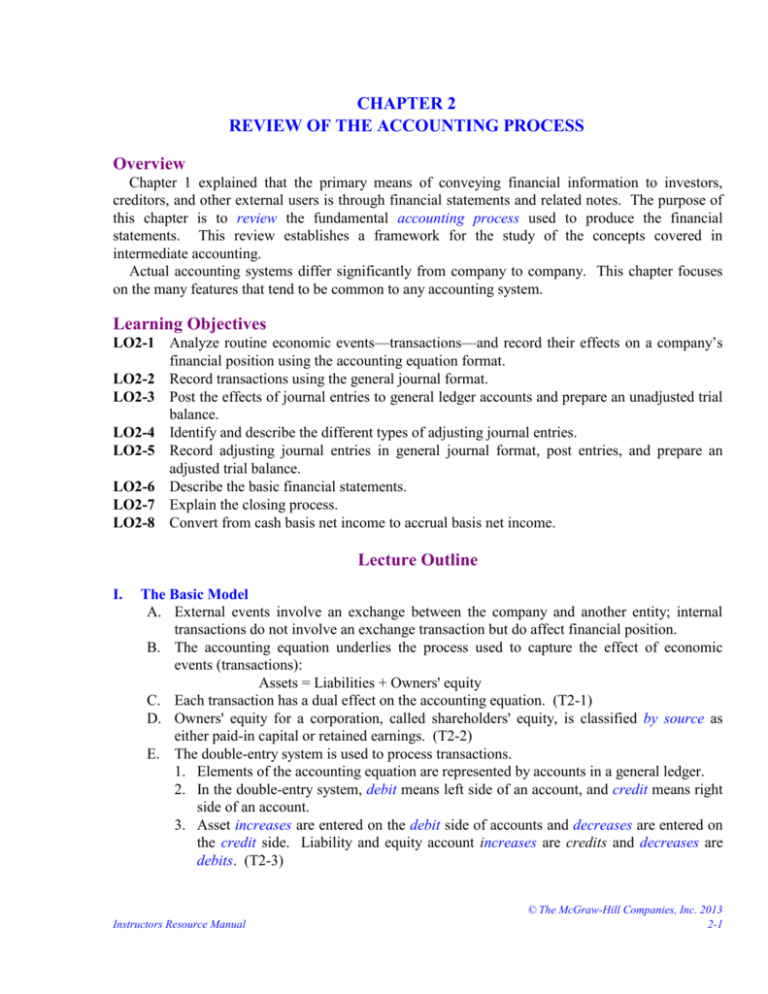
CHAPTER 2 REVIEW OF THE ACCOUNTING PROCESS Overview Chapter 1 explained that the primary means of conveying financial information to investors, creditors, and other external users is through financial statements and related notes. The purpose of this chapter is to review the fundamental accounting process used to produce the financial statements. This review establishes a framework for the study of the concepts covered in intermediate accounting. Actual accounting systems differ significantly from company to company. This chapter focuses on the many features that tend to be common to any accounting system. Learning Objectives LO2-1 Analyze routine economic events—transactions—and record their effects on a company’s financial position using the accounting equation format. LO2-2 Record transactions using the general journal format. LO2-3 Post the effects of journal entries to general ledger accounts and prepare an unadjusted trial balance. LO2-4 Identify and describe the different types of adjusting journal entries. LO2-5 Record adjusting journal entries in general journal format, post entries, and prepare an adjusted trial balance. LO2-6 Describe the basic financial statements. LO2-7 Explain the closing process. LO2-8 Convert from cash basis net income to accrual basis net income. Lecture Outline I. The Basic Model A. External events involve an exchange between the company and another entity; internal transactions do not involve an exchange transaction but do affect financial position. B. The accounting equation underlies the process used to capture the effect of economic events (transactions): Assets = Liabilities + Owners' equity C. Each transaction has a dual effect on the accounting equation. (T2-1) D. Owners' equity for a corporation, called shareholders' equity, is classified by source as either paid-in capital or retained earnings. (T2-2) E. The double-entry system is used to process transactions. 1. Elements of the accounting equation are represented by accounts in a general ledger. 2. In the double-entry system, debit means left side of an account, and credit means right side of an account. 3. Asset increases are entered on the debit side of accounts and decreases are entered on the credit side. Liability and equity account increases are credits and decreases are debits. (T2-3) Instructors Resource Manual © The McGraw-Hill Companies, Inc. 2013 2-1 II. The Accounting Processing Cycle A. Step 1. Obtain information about transactions from source documents. B. Step 2. Transaction analysis is the process of reviewing source documents to determine the dual effect on the accounting equation and the specific elements involved. C. Step 3. Record the transaction in a journal. (T2-4) For most external transactions, special journals (discussed in Appendix 2C) are used to capture the dual effect of the transaction in debit/credit form. D. Step 4. Post from the journal to the general ledger accounts. (T2-5) In addition to general ledger control accounts, a subsidiary ledger (discussed in Appendix 2C) contains a group of subsidiary accounts associated with particular general ledger control accounts. E. Step 5. Prepare an unadjusted trial balance. (T2-6) A worksheet (discussed in Appendix 2A) can be utilized as a tool after and instead of step 5 in the processing cycle. III. Adjusting Entries (T2-7) A. Step 6. Record adjusting entries and post to the ledger accounts. B. Prepayments are transactions in which the cash flow precedes expense of revenue recognition. (T2-8) 1. Prepaid expenses represent assets recorded when a cash disbursement creates benefits beyond the current reporting period. 2. Unearned revenues represent liabilities recorded when cash is received from customers in advance of providing a good or service. C. Accruals involve transactions where the cash outflow or inflow takes place in a period subsequent to expense or revenue recognition. (T2-9) 1. Accrued liabilities represent liabilities recorded when an expense has been incurred prior to cash payment. 2. Accrued receivables involve situations when the revenue is earned in a period prior to the cash receipt. D. Estimates often are made to comply with the accrual accounting model. (T2-10) 1. Most estimates involve either prepayments or accruals. 2. One situation involving an estimate that does not fit neatly into either the prepayment or accrual classification is accounting for bad debts. E. Step 7. Preparation of an adjusted trial balance. (T2-11) F. Accountants sometimes use reversing entries (discussed in Appendix 2B) in conjunction with adjusting entries. © The McGraw-Hill Companies, Inc. 2013 2-2 Intermediate Accounting, 7/e IV. Step 8. Prepare Financial Statements A. The income statement (T2-12) B. The statement of comprehensive income C. The balance sheet (T2-13) D. The statement of cash flows (T2-14) E. The statement of shareholders' equity (T2-15) V. Step 9. Close the Temporary Accounts (T2-16) A. Close the revenue accounts to income summary. B. Close the expense accounts to income summary. C. Close the income summary account to retained earnings. D. Step 10. Prepare a post-closing trial balance. (T2-17) VI. Conversion from Cash Basis to Accrual Basis (T2-18) A. Add (deduct) increases (decreases) in assets. For example, an increase in accounts receivable means that the company earned more revenue than cash collected. B. Add (deduct) decreases (increases) in accrued liabilities. For example, a decrease in interest payable means that the company incurred less interest expense than the cash interest paid, requiring the addition to cash basis-income. PowerPoint Slides A PowerPoint presentation of the chapter is available at the textbook website. Teaching Transparency Masters The following can be reproduced on transparency film as they appear here, or you can use the disk version of this manual and first modify them to suit your particular needs or preferences. Instructors Resource Manual © The McGraw-Hill Companies, Inc. 2013 2-3 TRANSACTION ANALYSIS Each transaction is analyzed to determine its effect on the equation and on the specific financial position elements. 1. An attorney invested $50,000 to open a law office. An investment by the owner causes both assets and owners’ equity to increase. Assets = + $50,000 (cash) Liabilities + Owners’ Equity + $50,000 (investment by owner) 2. $40,000 was borrowed from a bank and a note payable was signed. This transaction causes assets and liabilities to increase. A bank loan increases cash and creates an obligation to repay it. Assets = + $40,000 (cash) Liabilities + Owners’ Equity + $40,000 (note payable) 3. Supplies costing $3,000 were purchased on account. Buying supplies on credit also increases both assets and liabilities. Assets = + $3,000 (supplies) Liabilities + Owners’ Equity + $3,000 (accounts payable) Illustration 2-1 T2-1 © The McGraw-Hill Companies, Inc. 2013 2-4 Intermediate Accounting, 7/e TRANSACTION ANALYSIS (continued) 4. Services were performed on account for $10,000. Transactions 4, 5, and 6 are revenue and expense transactions. Revenues and expenses (and gains and losses) are events that cause owners’ equity to change. Revenues and gains describe inflows of assets, causing owners’ equity to increase. Expenses and losses describe outflows of assets (or increases in liabilities), causing owners’ equity to decrease. Assets = Liabilities + $10,000 (receivables) + Owners’ Equity + $10,000 (revenue) 5. Salaries of $5,000 were paid to employees. Assets = - $5,000 (cash) Liabilities + Owners’ Equity - $5,000 (expense) 6. $500 of supplies were used. Assets = - $500 (supplies) Liabilities + Owners’ Equity - $500 (expense) 7. $1,000 was paid on account to the supplies vendor. This transaction causes assets and liabilities to decrease. Assets = - $1,000 (cash) Liabilities + Owners’ Equity - $1,000 (accounts payable) Illustration 2-1 (continued) T2-1 (continued) Instructors Resource Manual © The McGraw-Hill Companies, Inc. 2013 2-5 ACCOUNTING EQUATION FOR A CORPORATION Owners' equity for a corporation, called shareholders' equity, is classified as either paid-in capital or retained earnings. Assets = Liabilities + Shareholders’ Equity Paid-in Capital Retained Earnings Revenues (+) Gains (+) Expenses (-) Losses (-) Dividends (-) Illustration 2-2 T2-2 © The McGraw-Hill Companies, Inc. 2013 2-6 Intermediate Accounting, 7/e ACCOUNTING EQUATION DEBITS AND CREDITS INCREASES AND DECREASES Assets = Liabilities + Paid-in Capital + Retained Earnings ___________ Debit + Credit ____________ _____________ Debit Debit - - Credit + - ________________ Credit Debit + - Credit + Expenses and Losses Revenues and Gains ________________ ________________ Debit + Credit - Debit - Credit + Illustration 2–3 T2-3 Instructors Resource Manual © The McGraw-Hill Companies, Inc. 2013 2-7 JOURNAL ENTRIES July 1 Two individuals each invested $30,000 in the corporation. investor was issued 3,000 shares of common stock. Each July 1 Borrowed $40,000 from a local bank and signed two notes. The first note for $10,000 requires payment of principal and 10% interest in six months. The second note for $30,000 requires the payment of principal in two years. Interest at 10% is payable each year on July 1, 2014, and July 1, 2015. July 1 Paid $24,000 in advance for one year’s rent on the store building. July 1 Purchased furniture and fixtures from Acme Furniture for $12,000 cash. July 3 Purchased $60,000 of clothing inventory on account from the Birdwell Wholesale Clothing Company. July 6 Purchased $2,000 of supplies for cash. July 4-31 During the month sold merchandise costing $20,000 for $35,000 cash. July 9 Sold clothing on account to St. Jude’s School for Girls for $3,500. The clothing cost $2,000. July 16 Subleased a portion of the building to a jewelry store. Received $1,000 in advance for the first two months’ rent beginning on July 16. July 20 Paid Birdwell Wholesale Clothing $25,000 on account. July 20 Paid salaries to employees for the first half of the month, $5,000. July 25 Received $1,500 on account from St. Jude’s. July 30 The corporation paid its shareholders a cash dividend of $1,000. Illustration 2-6 T2-4 © The McGraw-Hill Companies, Inc. 2013 2-8 Intermediate Accounting, 7/e GENERAL JOURNAL GENERAL JOURNAL Date Account Title and Explanation PAGE 1 Post Ref. Debit Cash Common stock To record the issuance of common stock. 100 300 60,000 Cash Notes payable To record the borrowing of cash and the signing of notes payable. 100 220 40,000 Prepaid rent Cash To record the payment of one year’s rent in advance. 130 100 24,000 Furniture and fixtures Cash To record the purchase of furniture and fixtures. 150 100 12,000 Inventory Accounts payable To record the purchase of merchandise inventory. 140 210 60,000 Supplies Cash To record the purchase of supplies. 125 100 2,000 Credit 2013 July 1 July 1 July 1 July 1 July 3 July 6 Instructors Resource Manual 60,000 40,000 24,000 12,000 60,000 2,000 © The McGraw-Hill Companies, Inc. 2013 2-9 July 4-31 July 4-31 July 9 July 9 July 16 July 20 July 20 July 25 July 30 Cash Sales revenue To record cash sales for the month. 100 400 35,000 Cost of goods sold Inventory To record the cost of cash sales. 500 140 20,000 Accounts receivable Sales revenue To record credit sale. 110 400 3,500 Cost of goods sold Inventory To record the cost of a credit sale. 500 140 2,000 Cash Unearned rent revenue To record the receipt of rent in advance. 100 230 1,000 Accounts payable Cash To record the payment of accounts payable. 210 100 25,000 Salaries expense Cash To record the payment of salaries for the first half of the month. 510 100 5,000 Cash Accounts receivable To record the receipt of cash on account. 100 110 1,500 Retained earnings Cash To record the payment of a cash dividend. 310 100 1,000 35,000 20,000 3,500 2,000 1,000 25,000 5,000 1,500 1,000 Illustration 2-7 T2-4 (continued) © The McGraw-Hill Companies, Inc. 2013 2-10 Intermediate Accounting, 7/e GENERAL LEDGER Cash GJ 1 GJ 1 60,000 40,000 24,000 100 GJ 1 Note Payable 220 40,000 GJ 1 Prepaid Rent 130 GJ 1 24,000 Common Stock 300 60,000 GJ 1 T2-5 Instructors Resource Manual © The McGraw-Hill Companies, Inc. 2013 2-11 UNADJUSTED TRIAL BALANCE DRESS RIGHT CLOTHING CORPORATION Unadjusted Trial Balance July 31, 2013 Account Title Cash Accounts receivable Supplies Prepaid rent Inventory Furniture and fixtures Accounts payable Note payable Unearned rent revenue Common stock Retained earnings Sales revenue Cost of goods sold Salaries expense Totals Debits 68,500 2,000 2,000 24,000 38,000 12,000 Credits 35,000 40,000 1,000 60,000 1,000 38,500 22,000 5,000 174,500 ____ 174,500 Illustration 2-9 T2-6 © The McGraw-Hill Companies, Inc. 2013 2-12 Intermediate Accounting, 7/e ADJUSTING ENTRIES Even when all external transactions and events are analyzed, journalized, and posted correctly to the appropriate ledger accounts, some account balances will require updating. Adjusting Entries Prepaid Expenses Prepayments Asset Expense Credit Debit Accrued Expenses Accruals Expense Liability Debit Credit ____________________ Unearned Revenues Liability Revenues Debit Credit ______________________ Accrued Receivables Asset Revenues Debit Credit _____________________ Illustration 2-10 T2-7 Instructors Resource Manual © The McGraw-Hill Companies, Inc. 2013 2-13 PREPAYMENTS Prepayments occur when the cash flow precedes either expense or revenue recognition. PREPAID EXPENSES Prepaid expenses represent assets recorded when a cash disbursement creates a benefit beyond the current reporting period. To record the cost of supplies used during the month of July. July 31 Supplies expense ................................. Supplies ........................................... Supplies 800 800 Supplies expense 2,000 800 800 __________ Balance 1,200 T2-8 © The McGraw-Hill Companies, Inc. 2013 2-14 Intermediate Accounting, 7/e PREPAYMENTS (continued) To record the cost of expired rent for the month of July. July 31 Rent expense ($24,000 ÷ 12) ................ 2,000 Prepaid rent ..................................... 2,000 To record depreciation of furniture and fixtures for the month of July. July 31 Depreciation expense ......................... Accumulated depreciation furniture and fixtures .................. 200 200 UNEARNED REVENUES Unearned revenues represent liabilities recorded when cash is received from customers in advance of providing a good or service. To record the amount of unearned rent revenue earned during July. July 31 Unearned rent revenue ....................... Rent revenue ................................... 250 250 T2-8 (continued) Instructors Resource Manual © The McGraw-Hill Companies, Inc. 2013 2-15 ACCRUALS Accruals involve transactions where the cash outflow or inflow occurs in a period subsequent to expense or revenue recognition. ACCRUED LIABILITIES Accrued liabilities represent liabilities recorded when an expense has been incurred prior to cash payment. To record accrued salaries at the end of July. July 31 Salaries expense .................................. 5,500 Salaries payable ............................... 5,500 To accrue interest expense for July on notes payable. $40,000 x 10% x 1/12 = $333 (rounded) July 31 Interest expense ................................... Interest payable................................ 333 333 T2-9 © The McGraw-Hill Companies, Inc. 2013 2-16 Intermediate Accounting, 7/e ACCRUED RECEIVABLES Accrued receivables involve situations when the revenue is earned in a period prior to the cash receipt. Assume that Dress Right loaned another corporation $30,000 at the beginning of August evidenced by a note receivable. Terms of the note call for the payment of principal, $30,000, and interest at 8% in three months. To accrue interest revenue earned in August on notes receivable. August 31 Interest receivable ...................................... Interest revenue ($30,000 x 8% x 1/12)...... 200 200 T2-9 (continued) Instructors Resource Manual © The McGraw-Hill Companies, Inc. 2013 2-17 ESTIMATES Estimates often are made to comply with the accrual accounting model. One estimate that does not fit neatly into either the prepayment or accrual classification is accounting for bad debts. T2-10 © The McGraw-Hill Companies, Inc. 2013 2-18 Intermediate Accounting, 7/e ADJUSTED TRIAL BALANCE DRESS RIGHT CLOTHING CORPORATION Adjusted Trial Balance July 31, 2013 Account Title Cash Accounts receivable Supplies Prepaid rent Inventory Furniture and fixtures Accumulated depreciation furniture and fixtures Accounts payable Notes payable Unearned rent revenue Salaries payable Interest payable Common stock Retained earnings Sales revenue Rent revenue Cost of goods sold Salaries expense Supplies expense Rent expense Depreciation expense Interest expense Totals Debits 68,500 2,000 1,200 22,000 38,000 12,000 Credits 200 35,000 40,000 750 5,500 333 60,000 1,000 38,500 250 22,000 10,500 800 2,000 200 333 180,533 _____ 180,533 Illustration 2-12 T2-11 Instructors Resource Manual © The McGraw-Hill Companies, Inc. 2013 2-19 THE INCOME STATEMENT DRESS RIGHT CLOTHING CORPORATION Income Statement For the Month of July 2013 Sales revenue Cost of goods sold Gross profit Operating expenses: Salaries Supplies Rent Depreciation Total operating expenses Operating income Other income (expense): Rent revenue Interest expense Net income $38,500 22,000 16,500 $10,500 800 2,000 200 13,500 3,000 250 (333) (83) $2,917 Illustration 2-13 T2-12 © The McGraw-Hill Companies, Inc. 2013 2-20 Intermediate Accounting, 7/e THE BALANCE SHEET DRESS RIGHT CLOTHING CORPORATION Balance Sheet At July 31, 2013 Assets Current assets: Cash Accounts receivable Supplies Inventory Prepaid rent Total current assets Property and equipment: Furniture and fixtures Less: Accumulated depreciation Total assets $ 68,500 2,000 1,200 38,000 22,000 131,700 $12,000 (200) 11,800 $143,500 Liabilities and Shareholders’ Equity Current liabilities: Accounts payable Salaries payable Unearned rent revenue Interest payable Note payable Total current liabilities Long-term liabilities: Note payable Shareholders’ equity: Common stock, 6,000 shares issued and outstanding Retained earnings Total shareholders’ equity Total liabilities and shareholders’ equity $ 35,000 5,500 750 333 10,000 51,583 30,000 $60,000 1,917 * 61,917 $143,500 * Beginning retained earnings + net income - dividends 0 + $2,917 - $1,000 = $1,917 Illustration 2-10 T2-14 Instructors Resource Manual © The McGraw-Hill Companies, Inc. 2013 2-21 THE STATEMENT OF CASH FLOWS DRESS RIGHT CLOTHING CORPORATION Statement of Cash Flows For the Month of July 2013 Cash Flows from Operating Activities: Cash inflows: From customers From rent Cash outflows: For rent For supplies To suppliers of merchandise To employees Net cash flows from operating activities $ 36,500 1,000 (24,000) (2,000) (25,000) (5,000) $(18,500) Cash Flows from Investing Activities: Purchase of furniture and fixtures Cash Flows from Financing Activities: Issue of common stock Increase in notes payable Payment of cash dividend Net cash flows from financing activities Net increase in cash (12,000) $ 60,000 40,000 (1,000) 99,000 $68,500 Illustration 2-15 T2-14 © The McGraw-Hill Companies, Inc. 2013 2-22 Intermediate Accounting, 7/e THE STATEMENT OF SHAREHOLDERS' EQUITY DRESS RIGHT CLOTHING CORPORATION Statement of Shareholders' Equity For the Month of July 2013 Balance at July 1, 2013 Issue of common stock Net income for July 2013 Less: Dividends Balance at July 31, 2013 Common Stock Retained Earnings -0$ 60,000 -0- ______ $ 60,000 $ 2,917 (1,000) $ 1,917 Total Shareholders’ Equity -0$ 60,000 2,917 (1,000) $ 61,917 Illustration 2-16 T2-15 Instructors Resource Manual © The McGraw-Hill Companies, Inc. 2013 2-23 THE CLOSING PROCESS To close the revenue accounts to income summary Sales revenue .............................................. 38,500 Rent revenue ............................................... 250 Income summary..................................... 38,750 To close the expense accounts to income summary Income summary......................................... 35,833 Cost of goods sold .................................. 22,000 Salaries expense...................................... 10,500 Supplies expense .................................... 800 Rent expense ........................................... 2,000 Depreciation expense ............................. 200 Interest expense ...................................... 333 Income Summary Expenses Revenues __________ Net income To close income summary to retained earnings Income summary......................................... 2,917 Retained earnings ................................... 2,917 After this entry is posted to the accounts, the temporary accounts have zero balances and retained earnings has increased by net income. T2-16 © The McGraw-Hill Companies, Inc. 2013 2-24 Intermediate Accounting, 7/e POST-CLOSING TRIAL BALANCE DRESS RIGHT CLOTHING CORPORATION Post-Closing Trial Balance July 31, 2013 Account Title Cash Accounts receivable Supplies Prepaid rent Inventory Furniture and fixtures Accumulated depreciation - furniture and fixtures Accounts payable Notes payable Unearned rent revenue Salaries payable Interest payable Common stock Retained earnings Totals Debits 68,500 2,000 1,200 22,000 38,000 12,000 _____ 143,700 Credits 200 35,000 40,000 750 5,500 333 60,000 1,917 143,700 Illustration 2-17 T2-17 Instructors Resource Manual © The McGraw-Hill Companies, Inc. 2013 2-25 CONVERSION FROM CASH TO ACCRUAL Converting from cash to accrual income: Add (deduct) increases (decreases) in assets. For example, an increase in accounts receivable means that the company earned more revenue than cash collected. Add (deduct) decreases (increases) in accrued liabilities. For example, a decrease in interest payable means that the company incurred less interest expense than the cash interest paid, requiring the addition to cash basis-income. The Krinard Cleaning Services Company maintains its records on the cash basis, with one exception. The company reports equipment as an asset and records depreciation expense on the equipment. During 2013, Krinard collected $165,000 from customers, paid $92,000 in operating expenses, and recorded $10,000 in depreciation expense, resulting in net income of $63,000. The owner has asked you to convert this $63,000 in net income to full accrual net income. You are able to determine the following information about accounts receivable, prepaid expenses, accrued liabilities, and unearned revenues: January 1, 2013 $16,000 7,000 Accounts receivable Prepaid expenses Accrued liabilities (for operating expenses) Unearned revenues 2,100 3,000 December 31, 2013 $25,000 4,000 1,400 4,200 Accrual net income is $68,500, determined as follows: Cash-basis net income Add: Increase in accounts receivable Deduct: Decrease in prepaid expenses Add: Decrease in accrued liabilities Deduct: Increase in unearned revenues Accrual basis net income $63,000 9,000 (3,000) 700 (1,200) $68,500 Illustration 2-18 T2-18 © The McGraw-Hill Companies, Inc. 2013 2-26 Intermediate Accounting, 7/e Suggestions for Class Activities 1. Spreadsheet Activities In addition to Exercise 2-19 and Problem 2-13, the requirements for Problems 2-2, 2-4, 2-6, 2-8, and 2-10 can be modified to include the use of software such as Lotus or Excel. 2. Professional Skills Development Activities The following are suggested assignments from the end-of-chapter material that will help your students develop their communication, analysis and judgment skills. Communication Skills. In addition to Communication Case 2-3, Judgment Cases 2-1 and 2-2 can be adapted to ask students to write a memo. These Judgment Cases also do well as group assignments and create good class discussions. Analysis Skills. The “Broaden Your Perspective” section includes Analysis Cases that direct students to gather, assemble, organize, process, or interpret data to provide options for making business and investment decisions. Exercises 2-14, 2-17 and Problems 2-7, 2-9 provide opportunities to develop and sharpen analytical skills. Judgment Skills. The “Broaden Your Perspective” section includes Judgment Cases that require students to critically analyze issues to apply concepts learned to business situations in order to evaluate options for decision-making and provide an appropriate conclusion. This chapter includes Judgment Cases 2-1 and 2-2. Instructors Resource Manual © The McGraw-Hill Companies, Inc. 2013 2-27 Assignment Chart Questions 2-1 2-2 2-3 2-4 2-5 2-6 2-7 2-8 2-9 2-10 2-11 2-12 2-13 2-14 2-15 2-16 2-17 2-18 2-19 2-20 2-21 Learning Objective(s) 1 1 2,3 3 2,3 2,3 1,2,3 1,2,3 3 2 3,5 4 7 4 4 4 6 A B C C Est. time Topic (min.) External and internal events 5 Dual effect of transactions on financial position 5 Purpose of journal and ledger 5 Permanent and temporary accounts 5 Debits and credits 5 Debits and credits 5 Accounting processing cycle 5 Transaction analysis 5 Posting 5 Journal entries 5 Trial balance 5 Adjusting entries 5 Closing entries 5 Adjusting entries—prepaid expenses 5 Adjusting entries—unearned revenue 5 Adjusting entries—accrued liabilities 5 Financial statements 5 Worksheet [Based on Appendix A] 5 Reversing entries [Based on Appendix B] 5 Special journals [Based on Appendix C] 5 Subsidiary ledger [Based on Appendix C] 5 Brief Exercises 2-1 2-2 2-3 2-4 2-5 2-6 2-7 2-8 2-9 2-10 2-11 2-12 Learning Objective(s) 1 2 3 2 5 4,5 5 4 6 6 7 8 Topic Transaction analysis Journal entries T-accounts Journal entries Adjusting entries Adjusting entries; income determination Adjusting entries Income determination Financial statements Financial statements Closing entries Cash versus accrual accounting © The McGraw-Hill Companies, Inc. 2013 2-28 Est. time (min.) 10 10 15 15 15 15 15 15 10 10 10 15 Intermediate Accounting, 7/e Exercises 2-1 2-2 2-3 2-4 2-5 2-6 2-7 2-8 2-9 2-10 2-11 2-12 2-13 2-14 2-15 2-16 2-17 2-18 2-19 2-20 2-21 2-22 2-23 2-24 Instructors Resource Manual Learning Objective(s) 1 2 3 2 2,3,4,5,6,7 2 2 5 5 4,5 6,7 7 7 4,5,8 2,5 4,8 8 8 A B B B C C Est. time Topic (min.) Transaction analysis 15 Journal entries 15 T-accounts and trial balance 15 Journal entries 20 The accounting processing cycle 15 Debits and credits 15 Transaction analysis; debits and credits 15 Adjusting entries 15 Adjusting entries 15 Adjusting entries; solving for unknowns 15 Financial statements and closing entries 20 Closing entries 10 Closing entries 10 Cash versus accrual accounting; adjusting entries 15 External transactions and adjusting entries 15 Accrual accounting income determination 15 Cash versus accrual accounting 20 Cash versus accrual accounting 20 Worksheet [Based on Appendix A] 35 Reversing entries [Based on Appendix B] 10 Reversing entries [Based on Appendix B] 10 Reversing entries [Based on Appendix B] 10 Special journals [Based on Appendix C] 15 Special journals [Based on Appendix C] 15 © The McGraw-Hill Companies, Inc. 2013 2-29 CPA Exam Questions CPA-1 CPA-2 CPA-3 CPA-5 CPA-5 Problems 2-1 2-2 2-3 2-4 2-5 2-6 2-7 2-8 2-9 2-10 2-11 2-12 2-13 Learning Est. time Objective(s) Topic (min.) 1 The effect of a transaction on the accounting equation 3 5 Accrued liabilities 3 8 Cash versus accrual accounting 3 8 Cash versus accrual accounting 3 8 Prepaid expenses 3 Learning Est. time Objective(s) Topic (min.) 2,3 Accounting cycle through unadjusted trial 40 balance 2,3 Accounting cycle through unadjusted trial 40 balance 5 Adjusting entries 20 Accounting cycle; adjusting entries through post- 60 3,5,6,7 closing trial balance 5 Adjusting entries 20 2,3,4,5,6,7 Accounting cycle 75 4,5 Adjusting entries and income effects 20 5 Adjusting entries 20 3,5,7 Accounting cycle; unadjusted trial balance 45 through closing 4,6,8 Accrual accounting; financial statements 30 8 Cash versus accrual accounting 15 8 Cash versus accrual accounting 40 A Worksheet [Based on Appendix A] 40 Star Problems Cases Judgment Case 2-1 Judgment Case 2-2 Communication Case 2-3 Learning Objective(s) Topic 4,8 Cash versus accrual; adjusting entries 8 Cash versus accrual; adjusting entries 4 Adjusting entries © The McGraw-Hill Companies, Inc. 2013 2-30 Est. time (min.) 20 30 20 Intermediate Accounting, 7/e


